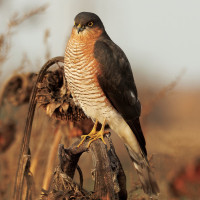Description
In a very pleasant and quite brief tour, it is possible to see birds that live between different environments, such as pine forest, dunes, cliffs, meadows and the sea. In the pine forest, you could find birds such as Eurasian Green Woodpecker, Great Spotted Woodpecker, Wren and Firecrest. In the mouth of the Pas, towards the end of the dunes, birds such as Osprey, Little Egret, Sanderling and Common Sandpiper can be seen. On the rocks and cliffs of the beaches of Valdearenas and Canallave it is possible to observe Dunlin, Great Cormorant, Black Redstart and Northern Wheatear. Sea birds can be seen from the beach itself, such as Sandwich Tern, Black-headed Gull and Northern Gannet. To the above, we must add the avifauna typical of the meadows that surround the pine forests such as European Goldfinch, European Stonechat, Red-billed Chough and Sparrowhawk.
_________________________
Espagnol: El Parque Natural de las Dunas de Lienres se encuentra delimitado por el Mar Cantábrico y un imponente pinar costero que es hogar para numerosas aves. En un recorrido muy agradable y bastante breve, es posible ver aves que viven entre ambientes distintos, como lo son el pinar, las dunas, los acantilados, las praderas y el mar. En el pinar, podríamos encontrar aves como el Eurasian Green Woodpecker, el Great Spotted Woodpecker, el Wren o el Firecrest. En la desembocadura del Pas, hacia el extremo de las dunas, pueden verse aves como el Osprey, la Little Egret, el Sanderling o el Common Sandpiper. En las rocas y acantilados de las playas de Valdearenas y Canallave es posible observar Dunlin, Great Cormorant, Black Redstart o Northern Wheatear. Desde la propia playa pueden verse aves marinas, como Sandwich Tern, Black-headed Gull o Northern Gannet. A too lo anterior, hay que sumar la avifauna propia de las praderas que rodean los pinares como European Goldfinch, European Stonechat, Red-billed Chough o Sparrowhawk.
Details
Access
Access to this site is very simple, since the Natural Park has several large parking lots. In summer, parking can be more complicated, since the beach is very crowded. However, it is always possible to park in the town of Liencres and make the walk a little longer. The roads are, as a general rule, simple and very flat. The only difficulties can be found in the section closest to the beach of Madero, inside the beaches themselves or if you want to explore forest outside the main route. Click on a P in the map for directions.
_________________________
Espagnol: El acceso a este sitio es muy sencillo, ya que el Parque Natural cuenta con varios aparcamientos de gran tamaño. En verano, aparcar puede ser más complicado, ya que la playa es muy turística. Sin embargo, siempre es posible aparcar en el pueblo de Liencres y hacer el paseo un poquito más largo. Los caminos son, por norma general, sencillos de andar y muy llanos. Las únicas dificultades se pueden encontrar en el tramo más cercano a la Playa del Madero, dentro de las propias playas o si se quiere recorrer le bosque fuera de la ruta principal.
